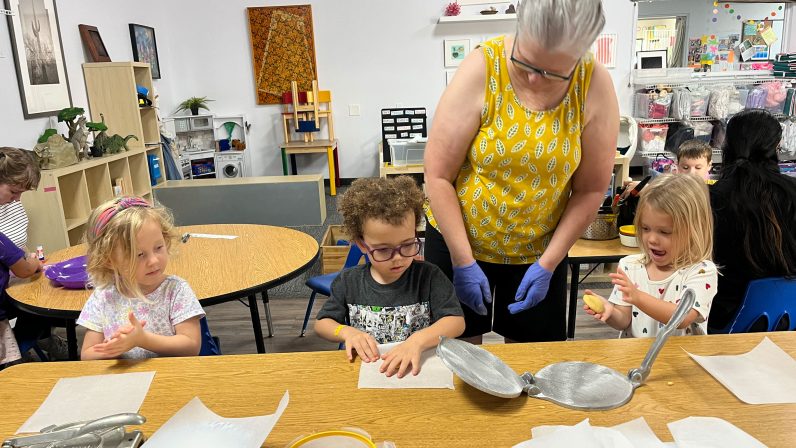September at the Seed has had another delicious and informative beginning. For the past two weeks, students of all ages have been immersed in explorations with food. Parents and grandparents have come to share the process of making pasta, banana muffins, tortillas, sopita, and pumpkin muffins. It’s been a blend of sensory exploration, learning nutrition basics, and understanding the interconnectedness of pollinators with the food chain. It’s always fascinating to see how teachers at each developmental level approach the topic of food.
Our youngest students start by engaging with food as a full sensory experience. They touch, smell, and see the foods before them. They make prints with berries, noodles, and veggies, often taking a taste before using them as an art expression. They experience different textures as they use their small hands to make handmade tortillas. Slightly older preschoolers make individual compost jars after reading the book Compost Stew. They learn that plastic doesn’t belong in compost, and worms love it.
Cooking projects are a big part of older preschool classrooms, and include such items as pinto beans, pesto made from scratch, smoothies, pico de gallo, and pumpkin muffins. They play restaurant, learn about food groups, and practice healthy eating.
Once students reach kindergarten, they make food graphs, create patterns with fruit kabobs, learn about MyPlate with their buddies, and make tortillas and beans to celebrate our Spanish teacher’s birthday. First and second grade students do similar cooking projects, learn more about food nutrients, document foods they’ve eaten in a week, play nutrition bingo, and are currently writing short stories about favorite foods. Here is first grader Ella’s book about Asian pears:
“I like Asian pears. An Asian pear is soft and crunchy. Asian pears grow on a tree. Asian pears are very special to my family because we’re Japanese. An Asian pear’s color is brownish and yellowish. It is greenish, it is reddish. An Asian pear is shaped like an oval. It grows up. It is tasty.”
The focus for our oldest Seeds this year is all things honey. Having chosen “The Hive” as their class name for 2025-2026, their attention is on bees and how their role as pollinators affects our food chain. This exploration will likely extend beyond the food study, as they learn about the vital part bees play in the existence of a multitude of foods we eat every day.
Even though our two-week food study is winding down, we hope it will have a lasting effect on our students as they continue trying new foods, learning about foods of different cultures, and developing a healthy relationship with food as they grow older.

